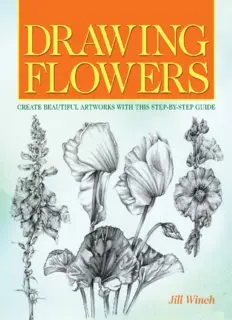
Drawing Flowers: Create Beautiful Artwork with This Step-by-Step Guide PDF
Preview Drawing Flowers: Create Beautiful Artwork with This Step-by-Step Guide
DRAWING FLOWERS CREATE BEAUTIFUL ARTWORKS WITH THIS STEP-BY- STEP GUIDE JILL WINCH Contents Introduction Chapter 1 Getting Started Chapter 2 First Stages Chapter 3 Flowers step-by-step Chapter 4 Leaves Chapter 5 Composition Index Introduction Drawing has always been a passion of mine; for as long as I can remember it has been important to me. However, it was only in later years, when I discovered botanical art and an inspirational teacher to guide me, that it grew into a love that would become part of my daily life. Encouraged by a lovely supportive family, I was fortunate to be able to follow my dream. This book is a wonderful opportunity for me to pass on the knowledge and experience I have gained, not only through years of drawing but also from teaching – knowing what is required to give someone the confidence to put pencil to paper and take them through the fundamentals of drawing. The book is designed for everyone, from the beginner to the more experienced. I hope to encourage the beginner to start drawing and inspire the more experienced artist to continue with the study of this fascinating topic. There is so much to learn from the study of flowers, and this book will take you on a journey on which you will not only look at how to draw the petals and leaves of the flower, but also bulbs, roots and the glorious seed heads that emerge at the end of the flowering season. Drawing is not a mystery known only to some and eluding others. Through continual practice and breaking down the process into small elements that make up the whole, you will find success – and the drawing of flowers is a magical way of learning. Jill Winch Chapter 1 Getting started In this chapter, we look at the equipment you need in order to embark on your flower drawing. Most of us, when we’re learning a new skill, will often buy too many materials at the outset through sheer enthusiasm, but this is often a waste of money. All that’s necessary to make a start here is a pencil, a sharpener, an eraser and some paper. With any materials, I strongly advise trying products from several manufacturers, since one brand’s 2H pencil will certainly be different from another, for example. I have discovered my own preferences over the years mainly by exploring what’s available from art supplies stockists rather than by following recommendations from other artists. Pencils and accessories While brands differ slightly in the range they offer, pencils are graded from 9H through to 9B, 9H being the hardest and 9B the softest, with HB and F in between. The H pencils can produce lovely light tones; for the darker shadow areas, I often use the softer B grades. The addition of small, intense areas of dark shading, made with a B pencil sharpened to a fine point with an emery board, can create instant drama in your drawing. Derwent, Faber-Castell and Staedtler are excellent manufacturers and you can buy a box with a good range of hard and soft leads. You can give the pencil lead an angled edge by using an emery board, which will enable you to produce both tone and very fine line. Clutch pencils are versatile and useful as you can expose the lead to the required length and grind it to a fine point, again with an emery board. These pencils sometimes have a removable sharpener at the end. Use this with caution, as the fine graphite dust can sometimes remain in the sharpener and spill out on to your paper. The leads are quite thick – usually 2–5mm. When you want a harder or a softer lead, change it by inserting it into the clutch mechanism at the tip. A propelling pencil differs from a clutch pencil in that the leads used are usually finer at 0.3mm, 0.5mm and 0.7mm, and you simply push the end of the casing to propel the lead forwards. These pencils can be used for fine, detailed work, but the lead is susceptible to snapping if you exert much pressure. There’s no need to sharpen it, as movement on the paper will produce the smooth edge that is required. Sharpeners Desk sharpeners can be clamped to the table surface, which makes them look sturdy and capable. However, they can sometimes make the lead in the pencil unstable, so the simple hand-held pencil sharpeners are not only a cheaper alternative but better, too. With repeated sharpening your pencils will become shorter, of course. A pencil extender is a handy tool which lengthens the barrel to give you extra grip and so prolongs the life of the pencil.
